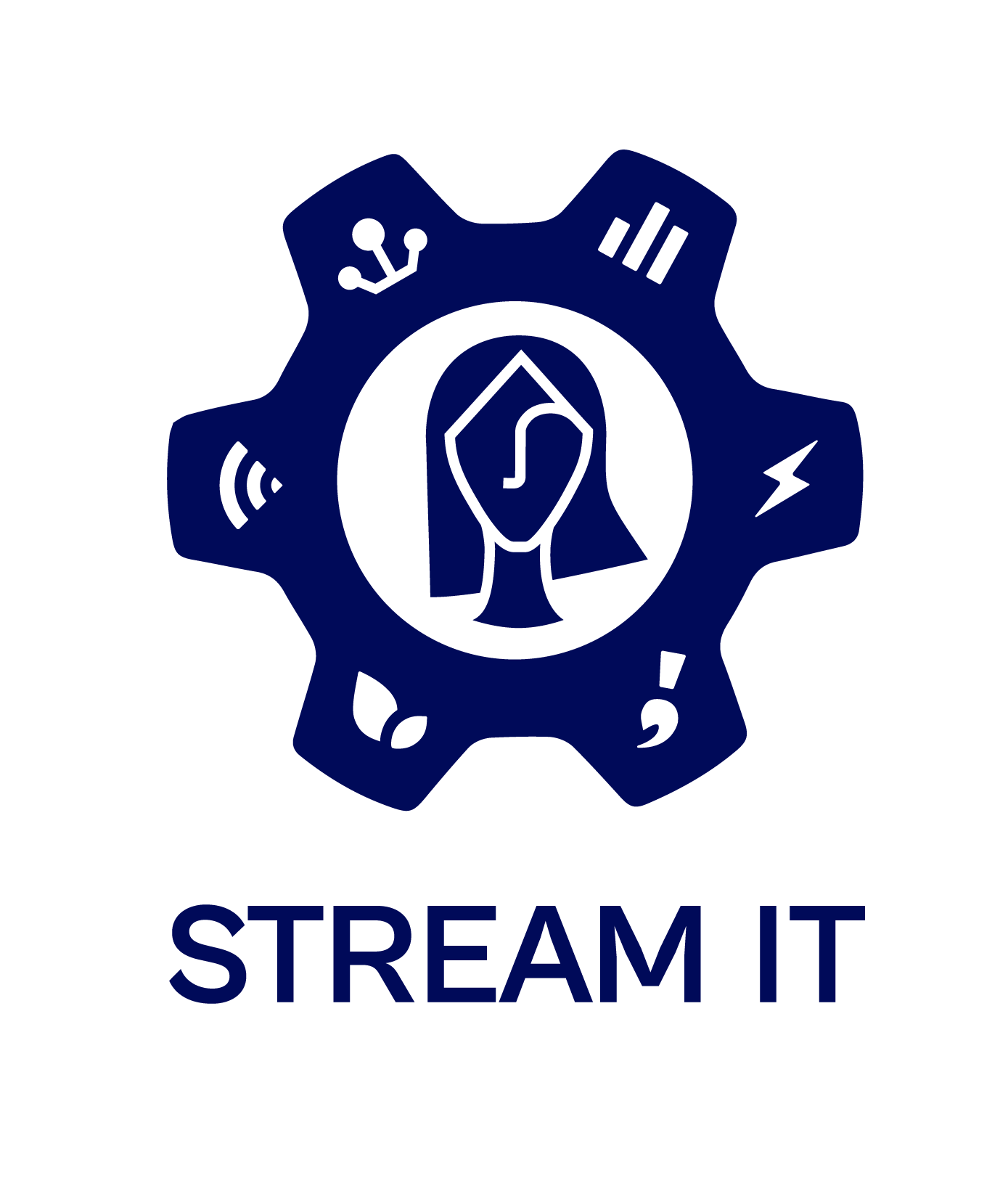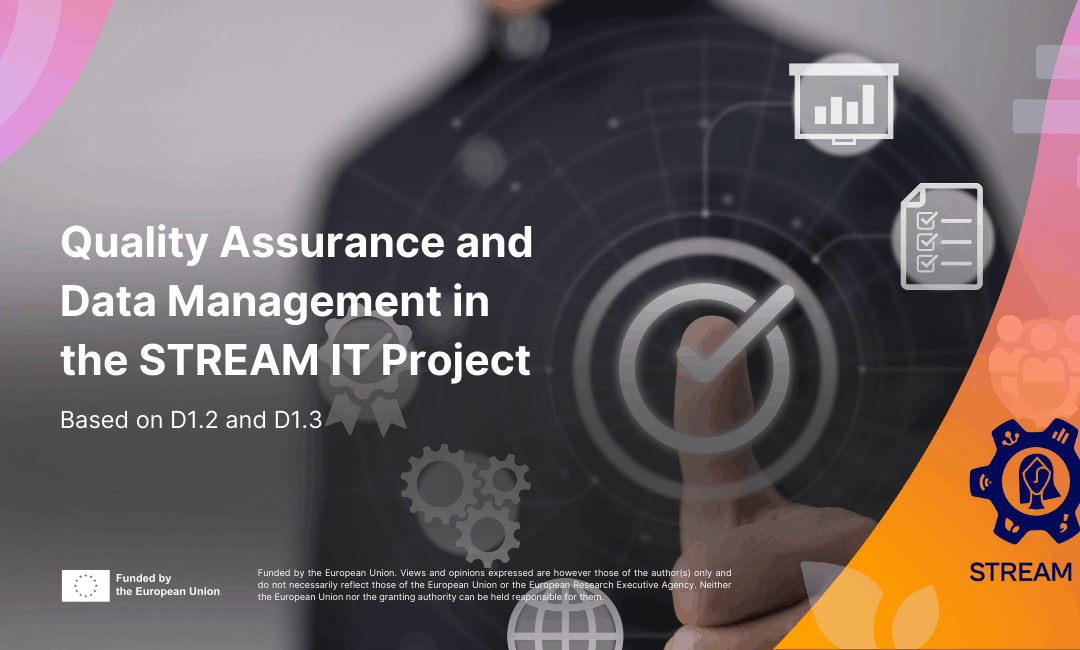The main objective of STREAM IT is to address gender inequalities in STEM education, research, and innovation, in line with the European Manifesto for gender-inclusive STE(A)M education and careers. The project focuses on empowering underrepresented groups, integrating STEAM approaches, promoting inclusive career paths, and supporting education providers. Through collaboration among businesses, institutions, and civil society, it offers practical tools to help close the gender gap in STEM.
To translate these objectives into measurable impact, the project must guarantee that outputs are reliable, transparent, and aligned with shared standards. This is where Quality Assurance (QA) and Data Management (DM) become indispensable. A strong Quality Assurance Plan (Deliverable 1.2) ensures the rigor and consistency of deliverables, while a comprehensive Data Management Plan (Deliverable 1.3) ensures that project data is handled responsibly, ethically, and sustainably. Both plans were developed under Work Package 1 under the lead of Steinbeis (S2i).
The Role of Quality Assurance
In complex, multi-partner projects such as STREAM IT, quality assurance is more than a procedural requirement – it represents a culture of excellence. The Quality Assurance Plan (Deliverable 1.2), led by Steinbeis (S2i), provides a clear framework that ensures deliverables are coherent and aligned with broader objectives. It creates a shared understanding across partners about what “quality” means, how it will be measured, and who is responsible for maintaining it.
The STREAM IT Quality Assurance framework rests on four key pillars:

Fig1: Flowchart of QA-Framework
- Concept Notes – Every deliverable begins with a detailed concept note, drafted before implementation. These notes outline the purpose, methodology, and expected outcomes, ensuring clarity from the outset and serving as a roadmap for work package leaders.
- Peer Review – Deliverables undergo structured peer review by partners with subject-matter expertise. This process identifies gaps, challenges assumptions, and ensures technical accuracy while also incorporating diverse perspectives.
- Iteration – Feedback from peer reviews is integrated into successive drafts. Iteration is treated as a process of refinement, improving coherence, precision, and impact.
- Coordinator Review – Final deliverables are submitted to the project coordinator for assessment of accuracy, comprehensiveness, and alignment with project objectives. Extraneous content is filtered out, ensuring only high-quality outputs move forward.
By embedding these stages into the QAP, STREAM IT ensures that quality is not an afterthought but a guiding principle throughout the project lifecycle.
Quality Assurance in Practice
Applying QA in practice requires more than structure – it requires collaboration. The STREAM IT project involves multiple organisations, each with distinct expertise, working across borders. Without a shared commitment to quality, fragmentation could undermine progress. The QAP provides common ground, ensuring that all outputs – whether research reports, training materials, or policy recommendations – meet consistent standards.
For instance, when developing educational resources to integrate arts into STEM teaching, concept notes ensure clarity of purpose: Are the materials accessible? Do they promote gender inclusivity? Peer review validates technical accuracy, while iteration allows refinements based on feedback. The coordinator review provides the final assurance that deliverables are impactful and aligned with project goals.
Through this structured cycle of planning, review, and refinement, STREAM IT reinforces its credibility while advancing inclusivity. Within the project, these processes are consistently applied, ensuring reliability across all work packages.
Data Management: Ensuring Transparency and Sustainability
While QA focuses on the quality of deliverables, Data Management ensures the reliability, accessibility, and preservation of the information underpinning them. In the era of open science, DM is no longer optional – it is essential for credibility and long-term impact.
The STREA)M IT Data Management Plan (Deliverable 1.3), also led by Steinbeis (S2i), provides the framework for handling all project data. It ensures compliance with Horizon Europe requirements and is fully aligned with the FAIR principles:

Fig2: Data Management plan
- Findable: Data sets are catalogued with rich metadata, making them easy to locate.
- Accessible: Information is made available in open repositories.
- Interoperable: Data formats are standardised to ensure compatibility across platforms.
- Reusable: Clear licenses and documentation enable others to build upon the work.
Beyond FAIR, Deliverable 1.3 also addresses ethical and security considerations. Gender-focused research often involves sensitive information, and protecting participants’ privacy is paramount. The plan includes measures for anonymisation, secure storage, and full GDPR compliance.
In addition, the DMP promotes open access to publications. All scientific outputs from STREAM IT are freely available, ensuring that findings reach not only academic circles but also educators, policymakers, and civil society. This openness is key to creating systemic change and dismantling gender barriers in STEM.
Synergy Between QA and Data Management
Though distinct, QA and DM reinforce each other. QA ensures deliverables are accurate and aligned with goals, while DM ensures that the underlying data is reliable, accessible, and ethically handled.
For example, a research report on gender disparities must pass through QA to validate its findings. At the same time, the data supporting the report must be curated and made openly available under the DMP. Without QA, the report risks inaccuracy; without DM, it lacks transparency and sustainability. Together, they create outputs that are both credible and reusable.
The leadership of Steinbeis in both Deliverable 1.2 (QAP) and Deliverable 1.3 (DMP) guarantees consistency, ensuring that quality and transparency move hand in hand.
Practical Lessons for Future Projects
The STREAM IT experience highlights key lessons for future initiatives:
- Start with Clear Frameworks – Establish QA and DM protocols early to ensure shared understanding.
- Embed Iteration – Treat feedback as essential for continuous improvement.
- Adopt FAIR Data Principles – Make data open, interoperable, and reusable.
- Balance Openness with Security – Promote transparency while safeguarding participant privacy.
- Evolve with the Project – Treat QA and DM plans as living documents that adapt to change.
Conclusion
The STREAM IT project shows that advancing inclusivity in STEM requires more than aspiration – it demands robust frameworks. By implementing the Quality Assurance Plan (Deliverable 1.2), the project guarantees that deliverables are consistent, credible, and aligned with goals. By following the Data Management Plan (Deliverable 1.3), it ensures data is open, ethical, and reusable.
Together, QA and DM form the foundation for lasting impact. They safeguard credibility, enhance transparency, and amplify contributions to systemic change. In striving for gender-inclusive STEM education and carries, the STREAM IT project proves that excellence and equity must go hand in hand.
Authors

Steinbeis Europa Zentrum
Marta Escoto de Tejada is a chemical engineer with a master’s in environmental engineering. Currently, she manages EU projects at Steinbeis Europa Zentrum, focusing mainly on communication, dissemination, and project administration. As a woman in STEM, she brings valued perspective to STREAM IT, where she is involved in the policy dialogue supporting the advancement of gender equality within STEAM fields across Europe.

Steinbeis Europa Zentrum
Dhanesh Chathuranga is an Architect and Smart City Consultant at Steinbeis Europa Zentrum in Germany, where he contributes to EU-funded innovation projects with a focus on policy-making, social innovation, and sustainable development. His work integrates architecture, technology, and policy to shape future-oriented urban solutions, while advancing STEM education as a catalyst for innovation and real-world impact.

